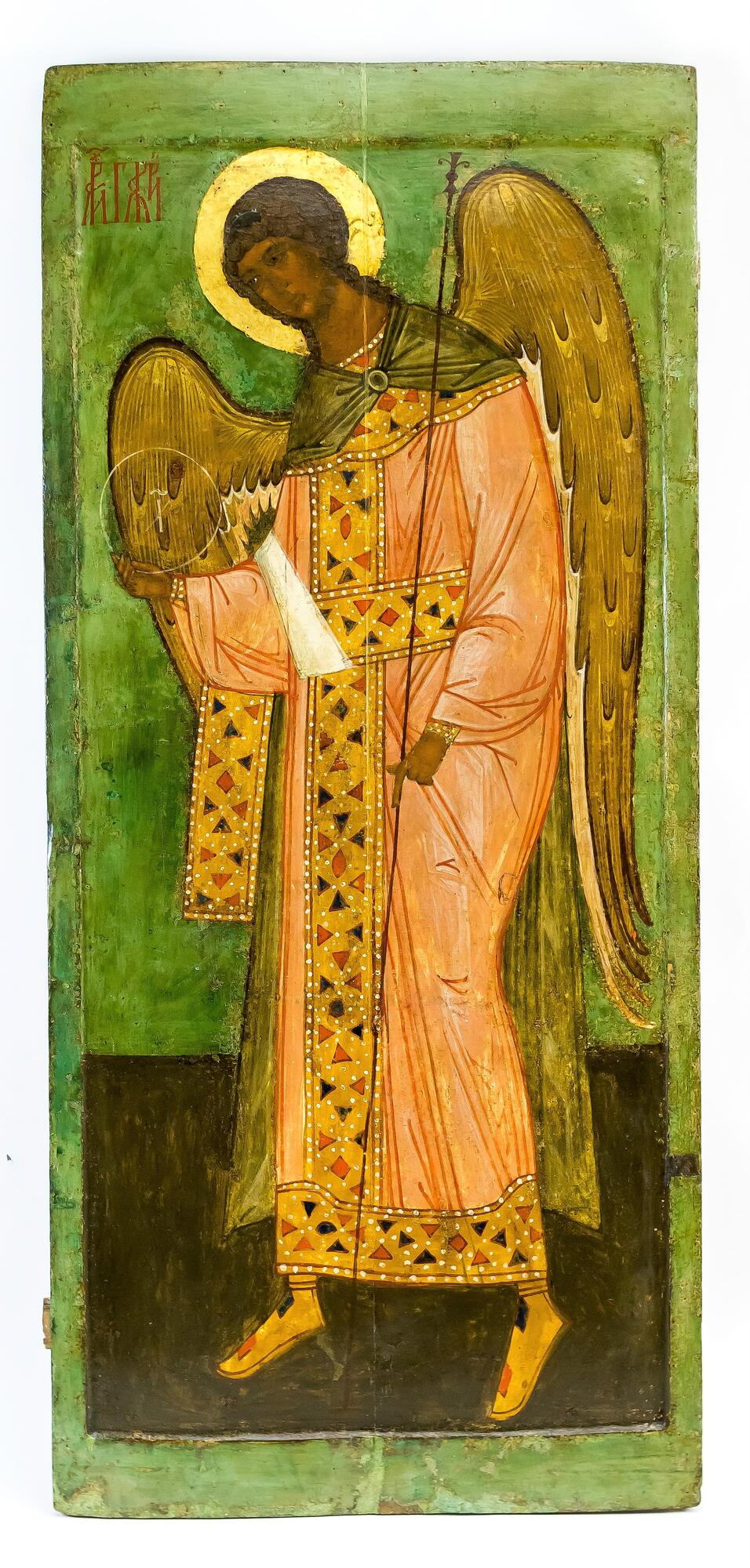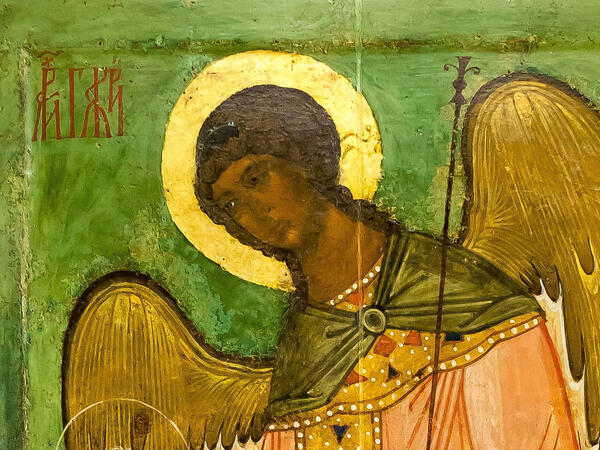‘The Archangel Gabriel’ was painted in the first half of the 16th century. It comes from the iconostasis of the ancient wooden Trinity Church in Sviyazhsk. The ‘Inventory of cadaster records and plat books of the city of Sviyazhsk by N.V. Borisov and D.A. Kikin (1565–1567)’ described thirteen images ‘in azure paint’. Almost a century later, in 1641, the Inventory of the Trinity-Sergius Monastery mentioned only ten icons and they were already ‘in green paint’. Nowadays, the icons of the Trinity Church belong to the museum: the funds contain the ten images of the Deesis row on a light green background.
The icon of the Archangel Gabriel is an image from the Deesis row of the Trinity Church iconostasis (the Greek word ‘deesis’ means ‘prayer’). The center of the Deesis row features the ‘Christ in Majesty’, which is a special image of Jesus Christ seated on a throne in the radiance of heavenly light, surrounded by cherubim and seraphim — the hosts of heaven. There are also saints who face Christ and pray to him, pleading for humanity.
The Archangel Gabriel is one of the seven archangels that are sent by God to explain prophetic visions and the meaning of various events to people. He is often called the Heavenly Messenger, for it was the Archangel Gabriel who announced the birth of Jesus Christ to the Virgin Mary. He also brought the news of the birth of John the Forerunner to his father Zechariah, the high priest of the Jerusalem temple. The Archangel Gabriel is depicted in the compositions ‘Annunciation’, ‘Nativity of Jesus’, in the Deesis row and on the deacons’ doors of the iconostasis.
The icon painter depicted the archangel according to traditional iconography. The figure is painted in full length, in a light pink royal garment called a dalmatic. The welt and shoulders of the robe, as well as the boots are painted with ocher, and their ornaments imitate precious stones and pearls. The Archangel Gabriel holds a mirror in his right hand — a transparent sphere which reveals the monogram of Jesus Christ. A “merilo” — the archangels’ attribute of power — is depicted as a thin baton and placed in the Archangel’s left hand. A green cloak is draped over Gabriel’s shoulders. The color scheme of the icon is based on the contrast between the light pink robes of the Archangel Gabriel and the light green background.
The face images in icons are painted using the ancient technique of ‘plav’’ — the application of thin translucent layers of paint, with smooth transitions from dark to light shades. The foundation for “lichnoe pismo” (painting of faces and bodies) is brown or olive sankir (the initial “underpaint” tone that creates volume and consists of dark ocher, soot and cinnabar). Each new layer is applied in a lighter tone enhancing the volume. The lichnoe pismo ends with ozhivki (final highlights of ceruse strokes). In ancient icon painting, a red tint (an intermediate layer between sankir and okhrenie — lighter colors over the dark base color) was usually placed on a saint’s cheeks. The icon of the Archangel Gabriel features brown sankir, a red tint and okhrenie made with the plav’ technique.
The icon of the Archangel Gabriel is an image from the Deesis row of the Trinity Church iconostasis (the Greek word ‘deesis’ means ‘prayer’). The center of the Deesis row features the ‘Christ in Majesty’, which is a special image of Jesus Christ seated on a throne in the radiance of heavenly light, surrounded by cherubim and seraphim — the hosts of heaven. There are also saints who face Christ and pray to him, pleading for humanity.
The saints include the Virgin Mary, John the Baptist, the archangels Michael and Gabriel, the apostles Peter and Paul, the saints Alexis and Peter, the metropolitans of Moscow, and the great martyr St. George.
The Archangel Gabriel is one of the seven archangels that are sent by God to explain prophetic visions and the meaning of various events to people. He is often called the Heavenly Messenger, for it was the Archangel Gabriel who announced the birth of Jesus Christ to the Virgin Mary. He also brought the news of the birth of John the Forerunner to his father Zechariah, the high priest of the Jerusalem temple. The Archangel Gabriel is depicted in the compositions ‘Annunciation’, ‘Nativity of Jesus’, in the Deesis row and on the deacons’ doors of the iconostasis.
The icon painter depicted the archangel according to traditional iconography. The figure is painted in full length, in a light pink royal garment called a dalmatic. The welt and shoulders of the robe, as well as the boots are painted with ocher, and their ornaments imitate precious stones and pearls. The Archangel Gabriel holds a mirror in his right hand — a transparent sphere which reveals the monogram of Jesus Christ. A “merilo” — the archangels’ attribute of power — is depicted as a thin baton and placed in the Archangel’s left hand. A green cloak is draped over Gabriel’s shoulders. The color scheme of the icon is based on the contrast between the light pink robes of the Archangel Gabriel and the light green background.
The face images in icons are painted using the ancient technique of ‘plav’’ — the application of thin translucent layers of paint, with smooth transitions from dark to light shades. The foundation for “lichnoe pismo” (painting of faces and bodies) is brown or olive sankir (the initial “underpaint” tone that creates volume and consists of dark ocher, soot and cinnabar). Each new layer is applied in a lighter tone enhancing the volume. The lichnoe pismo ends with ozhivki (final highlights of ceruse strokes). In ancient icon painting, a red tint (an intermediate layer between sankir and okhrenie — lighter colors over the dark base color) was usually placed on a saint’s cheeks. The icon of the Archangel Gabriel features brown sankir, a red tint and okhrenie made with the plav’ technique.


